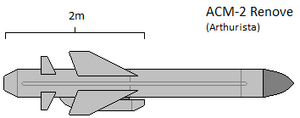ACM-2 Renove
| ACM-2 Renove | |
|---|---|
 | |
| Place of origin | Arthurista |
| Service history | |
| In service | 1973-present |
| Production history | |
| Manufacturer | Arthuristan Dynamics |
| Specifications | |
| Weight | 580kg |
| Length | 4.14m (air-launched) |
| Warhead | 230kg HEAP |
| Engine | turbojet |
Operational range | 120-280km (depending on version and launch platform) |
| Speed | High subsonic |
Guidance system | See below |
Launch platform | Ships, submarines, aircraft, trucks |
The ACM-2 Renove is an Arthuristan cruise missile, designed for stand-off anti-ship and land-attack applications. It is used by both the Commonwealth Navy and Commonwealth Air Force.
Design
The ACM-2 Renove was introduced in the early-1970s, to fill a long-standing gap in the Arthuristan inventory of air-launched sea-skimming weapon, as the Liothidia's development of increasingly capable warships made surface warfare a priority. Developing a weapon of this class would also allow the newly formed Arthuristan Dynamics export conglomerate a chance to compete with similar seaskimmers on the export market. The Renove features a turbojet sustainer engine for increased range. The missile follows a very low-altitude sea-skimming flight profile, and may be programmed to 'pop up' to acquire the target with its active-radar seeker before returning to sea-skimming flight for the final approach. An inertial guidance system provides for mid-course course stabilisation. At the terminal phase, the homing system takes over to guide the missile onto its target. Intended launch platforms include aircraft, trucks, surface ships and submarines. Those launched from the latter two platforms are equipped with a solid-rocket booster motor and are packaged as a water-proof 'sealed round' until arming and preparation for launch.
Renove Mk 1
The Renove Mk 1 was the initial version of the missile. The ACM-2A was a sea-skimming anti-ship missile featuring a J-band active-radar seeker, whereas the ACM-2B was a land-attack ordnance equipped with a TV camera for manual terminal guidance.
Renove Mk 2
The Renove Mk 2 upgrade was available around 1988. Modified with an enlarged fuel tank, a more fuel-efficient turbojet engine and weight-shedding measures using graphite technology, the missile's designers extended its engagement envelope to around 280km. An improved guidance package featuring SATNAV and computer software allowing for independent target assessment/re-attack capability were also added to the missile. The increased computing power of the ship's digital brain also allowed for the programming of evasive maneouvres in the terminal flight phase, as well as target-course memory for resistance against decoys and chaff. Optimised to operate in an intense ECM environment, the Renove is capable of picking out and locking onto specific vessels within a task group. A datalink allows for two-way communication between the missile, the launch platform and other sensor platforms.
ACM-2B(2) Land-attack cruise missile
The ACM-2B(2) features a new inertial navigation and SATNAV system, as well as a two-way datalink and terrain-following software. Terminal guidance is provided by the imaging infra-red seeker of the AGM-65D. The removal of the complex active-radar seeker enables the enlargement of the warhead to 360kg, with an improved shaped-charge design for increased penetration against hardened targets.
Renove Mk 3
The Renove Mk 3 is an export-oriented private project, equipped with the imaging infra-red seeker of the ACM-13 Lilith. Unlike the active-radar seeker used in previous anti-ship variants, the IIR seeker confers a completely radiation-silent attack capability, as well as greatly improved resistance to ECM. Compared to the ACM-13 Lilith, the Renove Mk 3 has doubled warhead weight, but lacks its stealth characteristics.